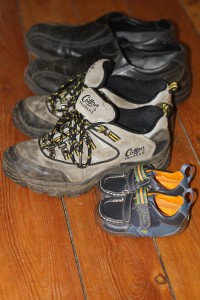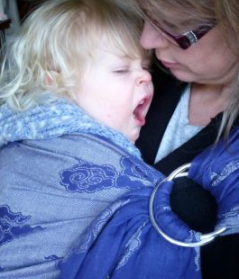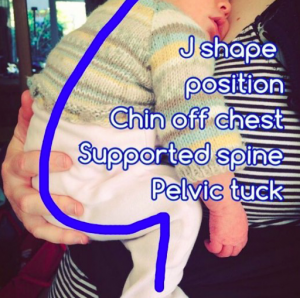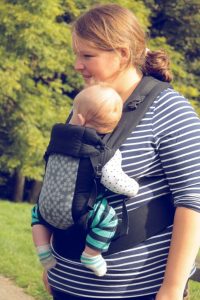“Help! My child cries in the sling… she seems to hate being put into it…”
This is a frequent worry faced by many parents when they try out a baby carrier for the first time – either the very first sling they have ever used, or when trying to find something more suitable or comfortable for their child’s needs as well as their own. I’ve come across many parents who are concerned that their child unfortunately hates the carrier they have spent money on, or convinced that there is no sling out there that will suit their baby as they always cry when they are put in.
Fear not – it is very common for babies and toddlers to fuss and cry and wriggle in slings, especially when it is a new experience, and my advice to parents in these circumstances is “don’t worry, this is very common, you are not alone” and “yes, there are solutions“. Crying in slings is common.
So why is it my baby cries as soon as I put her in a sling?
I think the key thing in such situations is to try and understand the experience the child is having – to put yourself in their shoes (or booties!)

Being able to see things through a baby’s eyes can often explain a whole host of issues – babies are small people with feelings just like adults, and they express these sensations in the more limited means they have at their disposal – laughing, wriggling, crying, bouncing, sucking, moaning, yelling, chewing, rooting, leaning, twisting etc. Being able to read and understand your baby’s cues is vital to a good relationship and this is one of the benefits of a carrier; parents and carers are usually much more aware and rapidly responsive to a child who is close to their bodies and visible, as opposed to one who is detached and in a pram or a bouncy chair or a play gym etc. So it is good, your baby is protesting, he/she is communicating with you and you are aware of that! Now to meet the need he/she is expressing and thereby solve the problem.. The sling itself is usually not the cause of baby’s displeasure.
What does your baby need?
- Is your baby too hot? (it is common to get very warm in a sling quickly. Your own body heat next to a baby’s with the extra layers of the sling will bring their temperature right up, and we all know its unpleasant to be sweaty and over-dressed.
- Is your baby thirsty?
- Is your baby hungry? It is always worth making sure your baby is well fed before wyou embark on a new experience – and come armed with bottles, snacks etc to satisfy any hunger. It is usually worth meeting this need rather than ignoring it, as babies won’t understand your priorities and will just continue to be upset. If you’re learning how to use the sling with someone, they will be more than happy for you to feed your baby – you are more likely to be able to absorb information when your child is happy. You can talk while feeding and still learn and you will always be able to try the carrier again later! Babies who are breast-fed may need to feed often, and few will refuse food that is offered, even if they’ve just been fed. Bringing a baby close to a chest full of milk will often create a desire to be fed, or to suck, even if tummies are full.. if you were a baby who could smell milk and were being held in a position where you couldn’t reach, it would be maddening, and you might kick, or wriggle, or yell.) If your baby seems to be burrowing down, or chewing their fingers, or shaking his head from side to side, could that be a cue to be fed? Perhaps you can learn to feed in the sling?
- Does your baby have a sore tummy or is he too full of food to tolerate pressure on his tummy, just like an adult after a large meal? A seated sideways carry may be more comfortable.
- Is your baby wet or dirty, and therefore uncomfortable, or are they needing to eliminate? Babies are very aware of their own bodily functions.
- Is your baby tired? Many babies have a fussy period before they go to sleep. You may already be aware of this tendency in your baby when they are falling asleep in bed, in the car, in the pram etc, the sling is no different. A baby may learn that slings often mean sleep and if he doesn’t wish to sleep, may protest. A little rocking with baby in sling is usually enough to help them drift off. Sometimes the new experience of trying a sling can be too much stimulation for a weary baby and push him over the edge from tiredness to tantrum, just as it would if you tried to feed him, or change his clothes. A good guide is two new things in a row (so at a sling meet, just try two things!)
- Is your baby in pain? Teething can be uncomfortable; distraction by play is a great tool, and if a baby suddenly has less distraction he may become aware once again of the ache in his jaws. Abdominal distension from constipation or sore genitalia may affect carrying.
- Is your baby responding to how she is being handled? Primitive reflexes like the Moro reflex (that causes the limbs to spread wide and then grasp) or the Tonic Labyrithine Reflex (over-extension, ie back arching due to an unsupported backward-lolling neck) can make babies feel insecure and unwilling to settle into a sling. Lifting and holding your baby securely from both the upper body and below the bottom can help to calm them before moving into a carrier.
- Is your baby responding to how you feel? If you are anxious or irritable while handling your baby, he will pick up on your muscle tone, shaky breathing and jerky movements and become distressed as something feels wrong. Sometimes it is better to just try again later when you are in a better frame of mind.
- Could you and your baby have some difficulties connecting, due to such circumstances as a complex pregnancy or a traumatic birth history (regardless of the objective outcome)? A lot of your unspoken feelings about your unborn baby and how your child arrived in the world can significantly affect bonding later, as can prolonged separation in the first few days or weeks of life. The rate of post-traumatic stress disorder after birth is surprisingly high (up to 9%) and there are several studies that demonstrate that such stress can impair bonding. This could be because of prematurity or illness, it could be due to feelings of guilt that are hard to shake off, even if they aren’t justified. Family dynamics and expectations, especially if they are in conflict with deep biological feelings can also have effects on how babies are handled and responded to. Babies are very sensitive to the feelings of their carers and will react accordingly – your baby’s behaviour and distress could be a signpost to some of your own internal discord and pain. This is where midwives, postnatal doulas and the NHS Afterthoughts services etc can be very helpful indeed in guiding families to find resolution and healing and I do recommend getting some support if you think this may be you.
In summary, if you and your baby are feeling good before you start, you are likely to have a more positive experience, and the more positive associations that are built up, the sooner your baby will begin to trust, enjoy and even ask for the carrier!
What is your baby’s personality?
This is an important aspect. I often meet people who almost expect their babies to become utterly still in a sling, and to remain very calm. Well, after all, they’re being carried close now, in a giant hug. What’s not to love? What’s not to be happy about??
Well, not everyone appreciates all-over cuddles, especially if they are not tired, and if they want to be active. This is where understanding your baby’s personality may be very useful… imagine you were playing happily and patting a colourful thing in front of you. All of a sudden you are lifted up and wrapped knee to neck in a giant warm bandage, or suddenly put into a carrier, possibly one where you can’t see very well. Some babies may love this; and settle down to happy drowsiness (usually because they are ready for cuddles, or are familiar with a well loved sling). Others may enjoy the sudden change of height and scenery and being able to smell their carer. Others may feel annoyed at being taken away from their happy activity, or be cross about not being able to see, or feel too hot, etc and don’t appreciate the abrupt change – these babies may strain and bounce and wriggle or cry in protest. Most children I meet are pretty active in some way – and it would be unreasonable to expect them to suddenly change from an active, inquisitive personality into a more docile, still and placid one, especially if the parent also stands strangely still, with their muscles all tense with anxiety about the use of the carrier and if baby will like it. “Mummy doesn’t feel right, she’s not soft and relaxed – this isn’t good.”
Remember as well, where is your child in their natural sleep-wake cycle? The more you’re able to understand your baby’s cues as they express themselves the more likely you are to be able to meet these needs before they feel they have to cry to be heard.
Tips to help you and your baby get used to a sling together
Practice makes perfect
Get confident with a demo doll first. Sling libraries and sling consultants are usually well stocked with weighted demo dolls which will allow you to figure out how to use the sling safely (remember the TICKS guidelines) and confidently. If you are very unsure while using the carrier, your baby will pick up on your nervousness and become unsettled.. this applies to every kind of carrier. This is why I always encourage people who come to me for help to use the dolls first, even if it feels like it will take longer… in the long run it will be more productive as you will have figured out which bits go where and how to tighten that section, so when it comes to trying it with your own child, you will be able to concentrate more on your child and how they are finding it, than simply getting it on. Even a teddy will help if you don’t have access to a demo doll. It’s the preparation (for example, knowing how to keep a child high on your body while you bring the panel up smoothly, or having a ring sling already set up can make a world of difference to the speed at which you can get the carrier on before your baby gets fed up!) Most babies will only tolerate a few “tries” with a sling, two, three at the most.
- Use your carrier daily, for you both to get used to it, even ten minutes at a time, building up gradually.
Involve your child in the whole process
- If possible, choose a time that baby is likely to be receptive to the sling; if she is fussing as she is experiencing an unmet need, the sling may not be the answer and merely exacerbate her cries.
- If baby is happily playing, do respect that, and don’t just snatch her away from her delighted learning. We’d feel a bit put out if someone just removed us from the middle of our day jobs to be cuddled – and for children, play is indeed their “work.” Sometimes you may not have a choice (eg school run time!)
- If the time is right, engage your baby during the process, make it fun!
- Tell her what you are doing and make the process of being put into the carrier enjoyable in its own right. A toy, a teether necklace, a song. Rock or sway while you go through each step, and take your time – there is no reason why you can’t stop halfway to go and show your baby her reflection in the mirror, for example, before carrying on. Babies have not yet learned how to be patient – they may spot a toy and want it at once – being denied the opportunity to get the toy can be frustrating and lead to wriggling.
Be caring and careful
- Observe how your baby likes to be carried in arms. Does she prefer hip carries? Does he love piggy backs? Try to reproduce this as far as you can. Babies are often “nosy” in the 4-8month period, and ring slings or hip carriers can be a brilliant way to carry a baby to meet their need to be inquisitive! Their preferences will often change as they grow. Try arms out for babies over 4months – freeing the shoulders can make a big difference!
- Check your baby is safe
(keeping his airway open and his breathing unobstructed is vital) – see link for more information on this
- Check that he is comfortable – if something feels wrong or hurts him, he will let you know somehow. Understanding how to create a comfortable position that allows deep relaxation is important. We all shift our positions without thinking during the day (eg recrossing legs, pulling up socks) and it is hard for a baby to do this as easily. We must be caring and careful. So familiarise yourself with the ideal M shape pelvic tuck position (knees above bum with pelvis tilted inwards) which will avoid any strain on the joints and allow a comfortable curve of the spine. Such a shift from a previously “splatted starfish” position to a hammock-shaped seat can really help. Ensure baby can move her legs freely at the knee (make the carrier narrower if needed) and no red marks are developing (raising the knees up can help with this problem). Babies should have free and easy access to their mouth with their hands for sucking or exploring. Check that fabric is not digging into baby’s neck (a muslin roll can help here) and that any knots, webbing or buckles are not pressing on baby’s body. Ensure baby feels secure, but not restrained or restricted (too tight carriers, or too large carriers, can pose problems of their own).
Keep your baby occupied!
Remember that your baby still wants to experience the world even while carried, as they do when playing on your lap or on the floor. Help them to be able to see a little, in a way that is appropriate for their age and still respectful of growing spines and hips. A carrier that has straps or fabric that comes close to the face may be irritating (do remember that babies grow taller, and many carriers can be adjusted to ensure faces and heads not obscured). Make sure that there is some activity going on – we all know about the sway we do to settle babies when carried in arms, and how often we shift them around, or the rocking/pushing of the pram – this gives a child some sensory input, rather than remaining still. I often encourage parents to go for a short walk round the block when they have just put a sling on with their baby – the motion and movement to get out of the house and the fresh air and change of scenery usually works wonders and parents come back with happier babies. Of course, once the parent is standing still again, and baby is bored with the reduced activity, he will protest!
Keep going!
Learning a new skill can take a little time and effort… both for you and for your baby. New experiences need to be absorbed and processed.. and every day is a new day, we all have off days, babies as well as their parents. If your baby cries in the sling, try using your carrier a little bit every day, for walks or participating in safe but engaging activities.. and bit by bit see if it gets easier and your baby becomes happier. The more relaxed and confident you are, the more your baby will respond to that (just like anything in life.) Don’t force it, take your cue from your baby! If after a good go, things still don’t feel right, try another one from your local sling library, and ask your friendly consultant/peer supporter to check your positioning – this is the best way to work out what carrier will suit each unique parent-child combination, and will save you money in the long run (you won’t buy a carrier that doesn’t work well!)
There are so many great things for you and your baby to gain from being able to use a sling – it is worth a little perseverance to get your carrying journey off to a great start, and hopefully this will be the beginning of a long and happy shared experience together!



 Get confident with a demo doll first. Sling libraries and sling consultants are usually well stocked with weighted demo dolls which will allow you to figure out how to use the sling safely (remember the
Get confident with a demo doll first. Sling libraries and sling consultants are usually well stocked with weighted demo dolls which will allow you to figure out how to use the sling safely (remember the 

 Remember that your baby still wants to experience the world even while carried, as they do when playing on your lap or on the floor. Help them to be able to see a little, in a way that is appropriate for their age and still respectful of growing spines and hips. A carrier that has straps or fabric that comes close to the face may be irritating (do remember that babies grow taller, and many carriers can be adjusted to ensure faces and heads not obscured). Make sure that there is some activity going on – we all know about the sway we do to settle babies when carried in arms, and how often we shift them around, or the rocking/pushing of the pram – this gives a child some sensory input, rather than remaining still. I often encourage parents to go for a short walk round the block when they have just put a sling on with their baby – the motion and movement to get out of the house and the fresh air and change of scenery usually works wonders and parents come back with happier babies. Of course, once the parent is standing still again, and baby is bored with the reduced activity, he will protest!
Remember that your baby still wants to experience the world even while carried, as they do when playing on your lap or on the floor. Help them to be able to see a little, in a way that is appropriate for their age and still respectful of growing spines and hips. A carrier that has straps or fabric that comes close to the face may be irritating (do remember that babies grow taller, and many carriers can be adjusted to ensure faces and heads not obscured). Make sure that there is some activity going on – we all know about the sway we do to settle babies when carried in arms, and how often we shift them around, or the rocking/pushing of the pram – this gives a child some sensory input, rather than remaining still. I often encourage parents to go for a short walk round the block when they have just put a sling on with their baby – the motion and movement to get out of the house and the fresh air and change of scenery usually works wonders and parents come back with happier babies. Of course, once the parent is standing still again, and baby is bored with the reduced activity, he will protest!